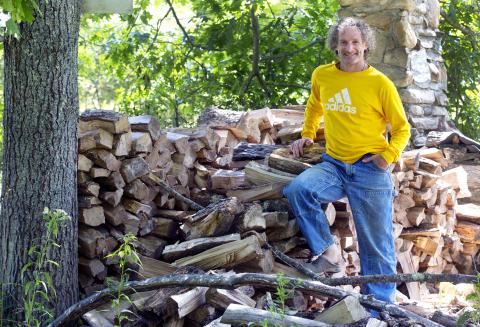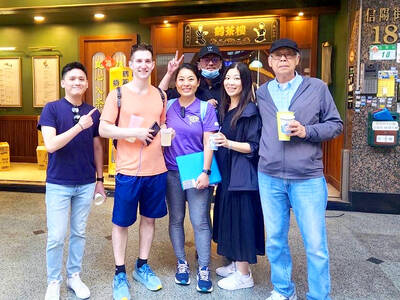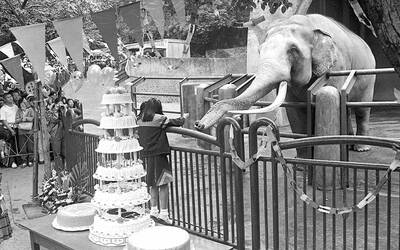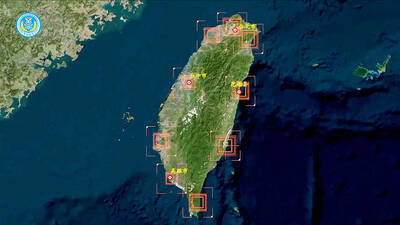In 2012, freelance journalist Theo Padnos slipped into Syria to cover its unfolding civil war and was promptly kidnapped by members of an al-Qaeda branch.
Convinced he was a CIA agent because he spoke Arabic, the group held the Massachusetts native for nearly two years before releasing him in August 2014.
Now, Padnos is retracing his journey in Theo Who Lived, a documentary being screened on Sept. 30 in Cambridge, Massachusetts. Its theatrical premiere is in New York City on Oct. 7, followed by a wider release.

Photo: AP
Padnos, 47, who has been living in Paris and Vermont, tells the Associated Press he’s grateful to have survived.
The ordeal not only changed his outlook on life but also gave him perspective on the Syrian conflict that he feels is important to share.
Padnos is working on a nonfiction book, a play and a novel drawing on his experience. He wrote about his captivity for the New York Times Magazine shortly after his release and is trying to continue writing about the region as a journalist.
“I had a real spiritual voyage, which was terrifying for me and my family at the time,” Padnos said from his family’s vacation home in Vermont. “But looking back, this is what life gave me and I’d like to take what I learned and turn it into some positive benefit.”
CLINGING TO HOPE
The film follows Padnos as he returns to places in Turkey and Israel that figured prominently in his 22-month capture. The film crew never set foot in Syria. Padnos reflects on his captivity on sets emulating his tiny prison cell and the room he was subjected to torture and beatings.
Along the Turkey-Syria border, he recalls the moment when his travelling companions instruct him to dash across the field and hop the razor wire fence separating them from Syria.
It’s a moment Padnos says he’d replay in his mind for months after.
The trio of men had claimed they were providing supplies to the Free Syrian Army and offered to take him across the border with them. But they were actually affiliated with al-Qaeda. They staged a fake interview, beat him and took him hostage shortly after crossing the border.
“This is where I threw my life away. It’s like a precipice that I walked up to and I actually jumped,” Padnos says in the film. “Now I’m back in a safe place and I’m thinking why did I ever jump?”
Padnos also details a series of failed escapes, including one in which cellmate and American photojournalist Matthew Schrier managed to sneak out through a narrow prison window but Padnos could not.
Padnos’ mother, Nancy Curtis, who is interviewed in the documentary, says she still has mixed emotions about her son’s release. During the ordeal, she became close to the parents of other Americans kidnapped by extremists overseas. Many of them were not as fortunate as her family, she says.
Curtis and other family members, working with the US and Qatari governments, successfully arranged for Padnos’ release just days after the Islamic State beheaded New Hampshire journalist James Foley in a video. The family maintains that no ransom was paid.
“I always clung to the hope that he’d come home,” Curtis said. “But I also don’t feel great joy and happiness. Probably anyone who has had a solider in the war who came home but knows others that didn’t have similar emotions.”
‘VERY HUMAN’
Director David Schisgall says Padnos’ story is a rare eyewitness account of life inside a jihadi group by an outsider with a deep understanding of the region’s language and culture.
Having spent years prior studying Arabic and Islam in Yemen and Syria, Padnos was able to build trust and friendships with some of his captors.
Near the end of his captivity, he was given greater freedoms and even traveled personally with the then-high commander of al-Nusra Front, an al-Qaeda affiliate in Syria.
“The real intimacy he developed with his captors was remarkable,” Schisgall said. “It’s a very important message for Americans to see these people fighting as complicated individuals who are both very dangerous but also very human.”

Eric Finkelstein is a world record junkie. The American’s Guinness World Records include the largest flag mosaic made from table tennis balls, the longest table tennis serve and eating at the most Michelin-starred restaurants in 24 hours in New York. Many would probably share the opinion of Finkelstein’s sister when talking about his records: “You’re a lunatic.” But that’s not stopping him from his next big feat, and this time he is teaming up with his wife, Taiwanese native Jackie Cheng (鄭佳祺): visit and purchase a

April 7 to April 13 After spending over two years with the Republic of China (ROC) Army, A-Mei (阿美) boarded a ship in April 1947 bound for Taiwan. But instead of walking on board with his comrades, his roughly 5-tonne body was lifted using a cargo net. He wasn’t the only elephant; A-Lan (阿蘭) and A-Pei (阿沛) were also on board. The trio had been through hell since they’d been captured by the Japanese Army in Myanmar to transport supplies during World War II. The pachyderms were seized by the ROC New 1st Army’s 30th Division in January 1945, serving

The People’s Republic of China (PRC) last week offered us a glimpse of the violence it plans against Taiwan, with two days of blockade drills conducted around the nation and live-fire exercises not far away in the East China Sea. The PRC said it had practiced hitting “simulated targets of key ports and energy facilities.” Taiwan confirmed on Thursday that PRC Coast Guard ships were directed by the its Eastern Theater Command, meaning that they are assumed to be military assets in a confrontation. Because of this, the number of assets available to the PRC navy is far, far bigger

The 1990s were a turbulent time for the Chinese Nationalist Party’s (KMT) patronage factions. For a look at how they formed, check out the March 2 “Deep Dives.” In the boom years of the 1980s and 1990s the factions amassed fortunes from corruption, access to the levers of local government and prime access to property. They also moved into industries like construction and the gravel business, devastating river ecosystems while the governments they controlled looked the other way. By this period, the factions had largely carved out geographical feifdoms in the local jurisdictions the national KMT restrained them to. For example,